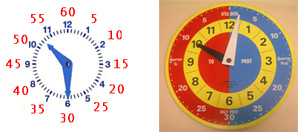Reading Clocks to Quarter Hours: 2.25
Supporting materials
Indicator of Progress
At this level students are able to read an analogue clock to the nearest quarter of an hour. They can draw a reasonable representation of an analogue clock-face. They know the equivalent digital time (e.g. they know that 3:15 is quarter past 3. 3:45 is a quarter to 4) and they are beginning to link these facts to the number of minutes in one hour (i.e. 15 is a quarter of 60, 45 is three quarters of 60). They know that each number on the clock represents a time period of 5 minutes.
Before this, they can read an analogue clock to hour or the nearest half-hour, and they can make some times on an analogue clock such as 8:30 and times such as 8:05 (seen as “a few minutes past 8”) without precisely positioning the hour hand. They can use a clearly marked timer to measure the duration of an event in whole numbers of minutes, or seconds, or hours.
This indicator builds on work on transformations in the Space dimension, which describes amount of turn by fractions of a complete revolution.
At this stage students are continuing to learn to measure time, as shown in the following diagram. After this they will learn to measure time with more accuracy (to minutes etc.) and later learn to calculate with time. See Measurement Phases.
Digital time is easy for students to ‘read’, but the visual models of the analogue clock provide strong support for students to understand the cycles of time and for beginning time calculations.
Three phases of teaching measurement

Illustration 1: Co-ordinating hour hands and minute hands
Students will already know that the hour hand on a clock moves continuously. Because the hour hand’s movement cannot be easily observed, students sometimes think that only the minute or second hands move all the time. Prior to this level, they will understand that the hour and minute hands move in a co-ordinated way, and that the position of the hour hand between two hours indicates the part of the hour that has gone. So in the image below, the hour hand as well as the minute hand, shows that half of the hour has past.

Illustration 2: Counting minutes in fives
Students at this level can use their knowledge of counting by fives to assist in learning to read the time. They can see that there are five divisions between each of the numbers on the classroom analogue clock and can count around the circle to 60 as below. They will know that zero is also at 12, along with 60.

Illustration 3

Examples of the types of tasks that would be illustrative of reading an analogue clock to the quarter hour, aligned from the Mathematics Online Interview:
- Question 39 (a) (b) (c) - Tell the time on an analogue clock
